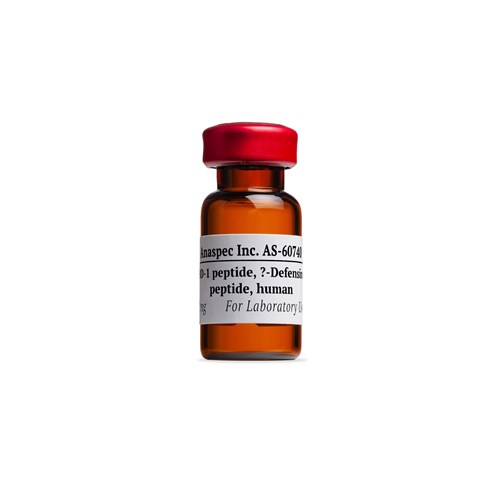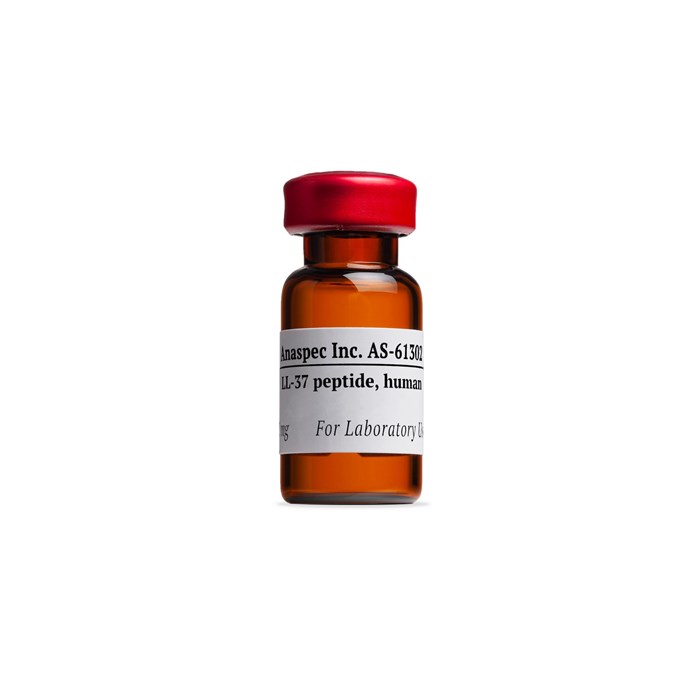LL-37, Antimicrobial Peptide, human - 1 mg
- Cat.Number : AS-61302
- Manufacturer Ref. :
-
Availability :
In stock
Alternative choices
Antimicrobial peptide LL-37, belonging to the cathelicidin family, is the first amphipathic alpha-helical peptide isolated from human. It plays an important role in the first line of defense against local infection and systemic invasion of pathogens at sites of inflammation and wounds. Cytotoxic to both bacterial and normal eukaryotic cells , LL-37 is significantly resistant to proteolytic degradation in solution.
Specifications
| Chemistry | |
| Sequence one letter code |
|
|---|---|
| Sequence three letter code |
|
| CAS registry number |
|
| Molecular Formula |
|
| Molecular Mass/ Weight |
|
| Modification | |
| Conjugation |
|
| Quantity & Purity | |
| Purity |
|
| Storage & stability | |
| Form |
|
| Storage Conditions |
|
| Activity | |
| Biomarker Target | |
| Research Area | |
| Sub-category Research Area | |
| Usage |
|
| Source | |
| Source / Species |
|
| Codes | |
| Code Nacres |
|
Downloads
You may also be interested in the following product(s)

Citations
Helical antimicrobial polypeptides with radial amphiphilicity.
Proc Natl Acad Sci U S A . 2012 Oct 12 ; 112(43) 13155 | DOI : 10.1073/pnas.1507893112
- M. Xiong
- et al
EptC of Campylobacter jejuni Mediates Phenotypes Involved in Host Interactions and Virulence
Infect Immun . 2012 Nov 26 ; 81(2) 430 | DOI : 10.1128/IAI.01046-12
- TW. Cullen
- et al
Structure-informed design of an enzymatically inactive vaccine component for group A Streptococcus.
mBio . 2013 Aug 06 ; 4(4) e00509 | DOI : 10.1128/mBio.00509-13
- A. Henningham
- et al
Lipopolysaccharide-Deficient Acinetobacter baumannii Shows Altered Signaling through Host Toll-Like Receptors and Increased Susceptibility to the Host Antimicrobial Peptide LL-37
Infect Immun. . 2013 Mar 01 ; 81(3) 684 | DOI : 10.1128/IAI.01362-12
- JH. Moffatt
- et al
Screening Antimicrobial Peptides In Vitro for Use in Developing Transgenic Citrus Resistant to Huanglongbing and Citrus Canker
Ameri Soci Horticul Sci . 2013 Mar 01 ; 138(2) 142 | DOI : https://doi.org/10.21273/JASHS.138.2.142
- E. Stover
- et al
d-Alanine Modification of a Protease-Susceptible Outer Membrane Component by the Bordetella pertussis dra Locus Promotes Resistance to Antimicrobial Peptides and Polymorphonuclear Leukocyte-Mediated Killing
J Bacteriol. . 2013 Sep 06 ; 195(22) 5102 | DOI : 10.1128/JB.00510-13
- NK. Taneja
- et al
Sulfolipid-1 Biosynthesis Restricts Mycobacterium tuberculosis Growth in Human Macrophages
ACS Chem Biol. . 2012 Feb 24 ; 7(5) 863 | DOI : 10.1021/cb200311s
- SA. Gilmore
- et al
Importance of the disulfide bridges in the antibacterial activity of human hepcidin
Peptides. . 2012 Jun 15 ; 36(2) 303 | DOI : 10.1016/j.peptides.2012.06.001
- A. Hocquellet
- et al
Vitamin D and the Human Antimicrobial Peptide LL-37 Enhance Group A Streptococcus Resistance to Killing by Human Cells
mBio . 2012 Oct 23 ; 3(5) e00394 | DOI : 10.1128/mBio.00394-12
- JF. Love
- et al
Cationic antimicrobial peptides serve as activation signals for the Salmonella Typhimurium PhoPQ and PmrAB regulons in vitro and in vivo.
Front Cell Infect Microbiol. . 2012 Jul 27 ; 2 102 | DOI : 10.3389/fcimb.2012.00102
- SM. Richards
- et al
Cathelicidin Antimicrobial Peptide Expression Is Not Induced or Required for Bacterial Clearance during Salmonella enterica Infection of Human Monocyte-Derived Macrophages
Infect Immun. . 2012 Aug 27 ; 80(11) 3930 | DOI : 10.1128/IAI.00672-12
- KL. Strandberg
- et al
Fatty Acids Regulate Stress Resistance and Virulence Factor Production for Listeria monocytogenes
J Bacteriol . 2012 Jul 27 ; 194 5274 | DOI : 10.1128/JB.00045-12
- Y. Sun
- et al
Cationic antimicrobial peptides disrupt the Streptococcus pyogenes ExPortal
Mol Microbiol . 2012 Jul 11 ; 85(6) 1119 | DOI : 10.1111/j.1365-2958.2012.08163.x
- LA. Vega
- et al
The bone marrow-expressed antimicrobial cationic peptide LL-37 enhances the responsiveness of hematopoietic stem progenitor cells to an SDF-1 gradient and accelerates their engraftment after transplantation
Leukemia . 2011 Sep 20 ; 26(4) 736 | DOI : 10.1038/leu.2011.252
- W. Wu
- et al
Hormonally Active Vitamin D3 (1α,25-Dihydroxycholecalciferol) Triggers Autophagy in Human Macrophages That Inhibits HIV-1 Infection
JBC . 2011 May 27 ; 286(21) 18890 | DOI : 10.1074/jbc.M110.206110
- GR. Campbell
- et al
Susceptibility of Pseudomonas aeruginosa Biofilm to Alpha-Helical Peptides: D-enantiomer of LL-37
Front Microbiol. . 2011 Jul 04 ; 2 128 | DOI : 10.3389/fmicb.2011.00128
- SN. Dean
- et al
Exopolysaccharides of Lactobacillus rhamnosus GG form a protective shield against innate immune factors in the intestine
Microb Biotechnol . 2010 Aug 17 ; 4(3) 368 | DOI : 10.1111/j.1751-7915.2010.00199.x
- S. Lebeer
- et al
The dlt operon confers resistance to cationic antimicrobial peptides in Clostridium difficile
Microbiology. . 2011 Feb 17 ; 157(Pt5) 1457 | DOI : 10.1099/mic.0.045997-0
- SM. McBride
- et al
Ampicillin Enhances Daptomycin- and Cationic Host Defense Peptide-Mediated Killing of Ampicillin- and Vancomycin-Resistant Enterococcus faecium
Antimicrob Agents Chemother. . 2011 Nov 28 ; 56(2) 838 | DOI : 10.1128/AAC.05551-11
- G. Sakoulas
- et al
Real-time attack on single Escherichia coli cells by the human antimicrobial peptide LL-37
PNAS . 2011 Apr 04 ; 108(16) E77 | DOI : 10.1073/pnas.1101130108
- KA. Sochacki
- et al
Mas-related gene X2 (MrgX2) is a novel G protein-coupled receptor for the antimicrobial peptide LL-37 in human mast cells: resistance to receptor phosphorylation, desensitization, and internalization.
J Biol Chem . 2011 Nov 08 ; 286(52) 44739 | DOI : 10.1074/jbc.M111.277152
- H. Subramanian
- et al
Antimicrobial and antibiofilm activity of cathelicidins and short, synthetic peptides against Francisella
BBRC . 2010 May 28 ; 396(2) 246 | DOI : https://doi.org/10.1016/j.bbrc.2010.04.073
- L. Amer
- et al
M Protein and Hyaluronic Acid Capsule Are Essential for In Vivo Selection of covRS Mutations Characteristic of Invasive Serotype M1T1 Group A Streptococcus
mBio. . 2010 Aug 31 ; 1(4) e00191 | DOI : 10.1128/mBio.00191-10
- JN. Cole
- et al
Fluorescence and UV Resonance Raman Study of Peptide−Vesicle Interactions of Human Cathelicidin LL-37 and Its F6W and F17W Mutants
Biochemistry. . 2009 Dec 01 ; 48(47) 11264 | DOI : 10.1021/bi900996q
- JE. Gable
- et al
Suppressive effect of the antimicrobial peptide LL‐37 on expression of IL‐6, IL‐8 and CXCL10 induced by Porphyromonas gingivalis cells and extracts in human gingival fibroblasts
Eur J Oral Sci. . 2010 Sep 30 ; 118(6) 574 | DOI : 10.1111/j.1600-0722.2010.00775.x
- KA. Inomata
- et al
Increased serum leucine, leucine-37 levels in psoriasis: Positive and negative feedback loops of leucine, leucine-37 and pro- or anti-inflammatory cytokines
Hum Immunol . 2010 Sep 16 ; 71(12) 1161 | DOI : https://doi.org/10.1016/j.humimm.2010.09.005
- N. Kanda
- et al
Antibacterial effect of human mesenchymal stem cells is mediated in part from secretion of the antimicrobial peptide LL-37.
Stem Cells . 2010 Oct 13 ; 28(12) 2229 | DOI : 10.1002/stem.544
- A. Krasnodembskaya
- et al
Burkholderia cenocepacia zinc metalloproteases influence resistance to antimicrobial peptides.
Microbiology. . 2009 Jun 18 ; 155(Pt9) 2818 | DOI : 10.1099/mic.0.028969-0
- C. Kooi
- PA. Sokol
LL-37 via EGFR Transactivation to Promote High Glucose–Attenuated Epithelial Wound Healing in Organ-Cultured Corneas
Invest Ophthalmol Vis Sci. . 2009 Sep 24 ; 51(4) 1891 | DOI : 10.1167/iovs.09-3904
- J. Yin
- FS. Yu
Toxins and antimicrobial peptides: interactions with membranes
Proc SPIE Int Soc Opt Eng. . 2009 Aug 21 ; 7397 pii73970J | DOI : 10.1117/12.827439
- DE. Schlamadinger
- et al
Impaired mobilization of hematopoietic stem/progenitor cells in C5-deficient mice supports the pivotal involvement of innate immunity in this process and reveals novel promobilization effects of granulocytes
Leukemia. . 2009 Aug 06 ; 23(11) 2052 | DOI : 10.1038/leu.2009.158
- HM. Lee
- et al
Acyl carrier protein is a bacterial cytoplasmic target of cationic antimicrobial peptide LL-37
Biochem J . 2015 Jul 17 ; 470(2) 243 | DOI : 10.1042/BJ20150432.
- MC. Chung
- et al
Chlamydial plasmid-encoded virulence factor Pgp3 neutralizes the antichlamydial activity of human cathelicidin LL-37
Infect Immun . 2015 Sep 28 ; 83(12) 4701 | DOI : 10.1128/IAI.00746-15
- S. Hou
- et al
Decreased outer membrane permeability protects mycobacteria from killing by ubiquitin-derived peptides.
Mol Microbiol . 2009 Aug 06 ; 73(5) 844 | DOI : 10.1111/j.1365-2958.2009.06801.x.
- GE. Purdy
- et al
Clostridium difficile clinical isolates exhibit variable susceptibility and proteome alterations upon exposure to mammalian cationic antimicrobial peptides.
Anaerobe . 2012 Sep 24 ; 18(6) 614 | DOI : 10.1074/jbc.M110.206110
- R. McQuade
- et al
Structure–activity relationship of human liver-expressed antimicrobial peptide 2.
Peptides . 2010 Jan 31 ; 31(1) 58 | DOI : 10.1016/j.peptides.2009.10.006
- A. Hocquellet
- et al
β-Defensins activate human mast cells via Mas-Related Gene X2.
J Immunol . 2013 May 22 ; 191(1) 345 | DOI : 10.4049/jimmunol.1300023.
- H. Subramanian
- et al
Fluorescence and UV resonance Raman study of peptide−vVesicle interactions of human cCathelicidin LL-37 and its F6W and F17W mutants
Biochem . 2009 Dec 01 ; 48(47) 11264 | DOI : 10.1021/bi900996q.
- JE. Gable
- et al
